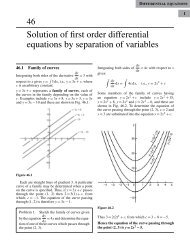vector
You also want an ePaper? Increase the reach of your titles
YUMPU automatically turns print PDFs into web optimized ePapers that Google loves.
Vectors 431<br />
=<br />
<br />
2<br />
0<br />
<br />
2 2<br />
ˆ ˆ 2 ˆ 4 ˆ 3<br />
4 2<br />
ˆ<br />
x y<br />
dx yi xyj yk x yi x yj kˆ<br />
<br />
<br />
<br />
2 <br />
2 4 3 2<br />
= ˆ ˆ ˆ ˆ ˆ ˆ<br />
(16i 8xj 16k 4xi 4x j 8 xk)<br />
dx<br />
0<br />
2<br />
<br />
5 3<br />
2 4 4 8<br />
= ˆ ˆ ˆ x<br />
16 4 16 ˆ ˆ<br />
x <br />
xi x j xk i x j kˆ<br />
<br />
<br />
5 3 0<br />
128 64<br />
= 32 ˆ 16 ˆ 32 ˆ ˆ 16 ˆ ˆ 32 iˆ<br />
32kˆ<br />
i j k i j k = = 32 (3iˆ<br />
5 kˆ<br />
)<br />
5 3 5 3 15<br />
EXERCISE 5.12<br />
1. If F <br />
= 2<br />
(2x 3) z iˆ2xyj ˆ 4 xkˆ<br />
, then evaluate FdV , where V is bounded by the plane<br />
V<br />
4<br />
0<br />
Ans.<br />
x = 0, y = 0, z = 0 and 2x + 2y + z = 4. Ans. 8 3<br />
2. Evaluate dV ,<br />
V where = 45 x 2 y and V is the closed region bounded by the planes<br />
4x + 2y + z = 8, x = 0, y = 0, z = 0 Ans. 128<br />
3. If F = (2x 2 <br />
– 3z) iˆ<br />
2xyj ˆ 4 xkˆ<br />
, then evaluate FdV<br />
, where V is the closed region bounded<br />
V<br />
8<br />
by the planes x = 0, y = 0, z = 0 and 2x + 2y + z = 4.<br />
Ans. ( ˆ ˆ)<br />
3 j k<br />
4. Evaluate (2 x<br />
y) dV , where V is closed region bounded by the cylinder z = 4 – x 2 and the planes<br />
V<br />
x = 0, y = 0, y = 2 and z = 0. Ans. 80 3<br />
5. If F 2<br />
= 2 ˆ ˆ ˆ<br />
<br />
xz i xj y k,<br />
evaluate<br />
F dV over the region bounded by the surfaces x = 0, y = 0,<br />
y = 6 and z = x 2 , z = 4. Ans. (16iˆ3ˆj 48 kˆ<br />
)<br />
5.36 GREEN’S THEOREM (For a plane)<br />
<br />
Statement. If (x, y), (x, y), and be continuous functions over a region R bounded<br />
y<br />
x<br />
by simple closed curve C in x – y plane, then<br />
( dx<br />
dy)<br />
= <br />
<br />
dx dy<br />
C<br />
R<br />
<br />
x<br />
y<br />
(AMIETE, June 2010, U.P., I Semester, Dec. 2007)<br />
Proof. Let the curve C be divided into two curves C 1<br />
(ABC) and C 1<br />
(CDA).<br />
Let the equation of the curve C 1<br />
(ABC) be y = y 1<br />
(x) and equation of the curve C 2<br />
(CDA) be<br />
y = y 2<br />
(x).<br />
Let us see the value of<br />
<br />
dx dy = xc<br />
y<br />
y<br />
2<br />
( x)<br />
<br />
dy dx<br />
R y<br />
xa y y ( x)<br />
<br />
1 y<br />
<br />
= c 2 ( )<br />
( , )<br />
y <br />
x y<br />
y x<br />
dx<br />
a<br />
y y ( x)<br />
1<br />
c<br />
a<br />
c<br />
= ( x, y2) ( x, y1)<br />
dx = ( x, y2) dx ( x, y1)<br />
dx<br />
a<br />
a<br />
c<br />
= <br />
<br />
( x, y2) dx ( x, y1)<br />
dx<br />
<br />
c<br />
a<br />
<br />
= <br />
<br />
( x , y ) dx ( x , y ) dx<br />
<br />
<br />
c2 c1<br />
<br />
= – ( , )<br />
<br />
c<br />
c<br />
<br />
a<br />
x y dx










